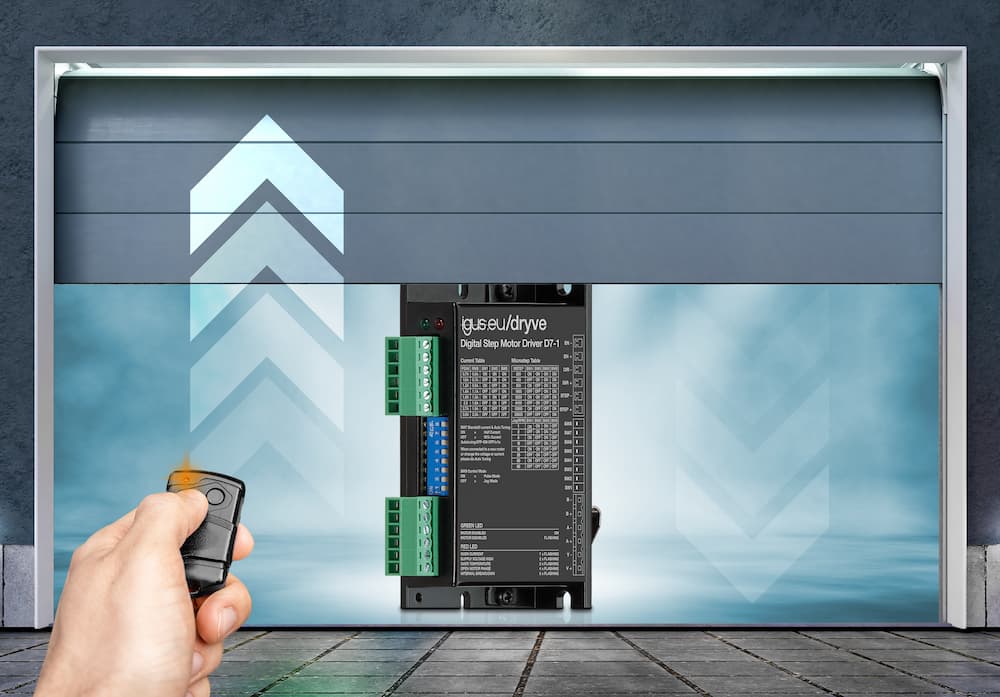Avoid long PLC lead times with igus step direction motor driver for low-cost automation
24/08/2022

Get your automation system commissioned quickly – simple PLC alternatives from £80 are available directly from stock
For many simple automated operations, like adjusting the width of a conveyor guiding edge or the height of a monitor, programmable logic controllers (PLCs) are often oversized and not necessary. Alternatives from igus are the step direction motor drives D7, D8 and D9 in the dryve series. Among advantages like cost, they are characterised by their simple operation and smooth running. The motor drivers are also available directly from stock for fast delivery.
Automation projects do not always have to use a PLC, especially when it comes to simple operations. The right choice can save money and effort. “Demand is high for simple step direction motor drivers that are reliable, cost-effective and easy to operate – but at the same time flexible enough so they can work together with a modern PLC to expand the range of possibilities”, explains Adam Sanjurgo, Low Cost Automation Product Manager at igus. “We have therefore extended our dryve series motor control systems to include the three motor drives D7, D8 and D9 as well as other variants. These are already available from £80.”
Quick manual adjustment without tools
To help users save installation time, igus has invested in fast commissioning of the control system. Users just connect the voltage source, control signals and the motor to the output stage and they are up and running. In the “JOG” operating mode, a signal triggered by a push-button initiates the anti-clockwise motor rotation, and a second signal triggered by a second push-button initiates the clockwise rotation. The motor current and the speed of the drive can be adjusted via eight microswitches on the housing, similar to a timer. It does not need software or additional tools. Predefined motor speeds between one and 500 rpm are possible, depending on the output stage variant.
Smooth operation protects the adjacent components
Not only is it quick and intuitive to install and control the new motor drivers, they also operate quietly. “At all speeds, the motor drivers operate exceptionally quietly thanks to the use of high quality electronic components”, says Sanjurgo. “Many inferior motor drives cause stepper motors to vibrate. The vibrations create noises and can result in screws and other components coming loose.”
Despite their minimalism, it is still possible to expand the applications of the drives. Users can connect a higher-level control system via a standardised step/direction interface. In pulse operating mode, for example, it is then possible to implement precise positioning with simple step/direction signals. To make sure designers can integrate the output stage into larger systems as early as the planning phase without friction losses, igus also offers EPLAN macros for the drives, for download. Users of the EPLAN planning software can import the macro and design circuit diagrams virtually. “Doing this can reduce the design time by up to 50%,” Sanjurgo says.
Quick installation in a switch cabinet is also guaranteed thanks to the TS35 DIN rail format. Furthermore, igus offers free sample programmes for higher-level machine control systems, provided by Siemens or Arduino for example.
New output stage variant for more movement possibilities
The new drives are available in three sizes and are ready to ship in 24 hours. The D7 version is suitable for stepper motors with up to 2.2A continuous current (NEMA 11/17), D8 for motors with up to 4A continuous current (NEMA 23/24) and D9 for motors with up to 7A continuous current (NEMA 34). All designs have sub-variants, which increase the flexibility of movement. D7-1, for example, is suitable for the JOG operating mode with slow speeds between one and 50rpm. And D7-2 replaces the JOG mode with a LOOP mode of operation, which, for example in a cleaning system, ensures that a nozzle moves continuously from left to right and right to left.
